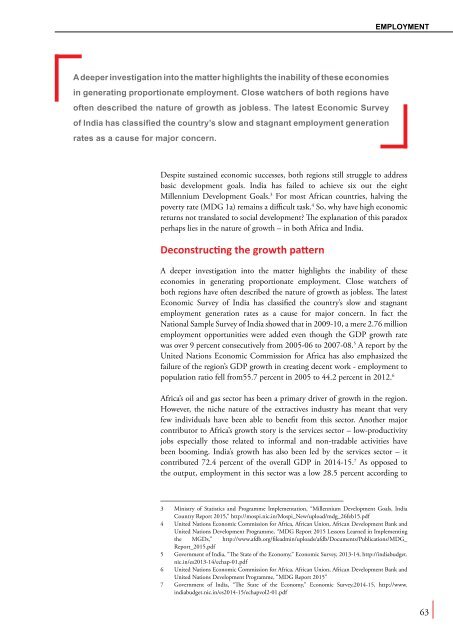Common Futures
II3UUw
II3UUw
Create successful ePaper yourself
Turn your PDF publications into a flip-book with our unique Google optimized e-Paper software.
Employment<br />
A deeper investigation into the matter highlights the inability of these economies<br />
in generating proportionate employment. Close watchers of both regions have<br />
often described the nature of growth as jobless. The latest Economic Survey<br />
of India has classified the country’s slow and stagnant employment generation<br />
rates as a cause for major concern.<br />
Despite sustained economic successes, both regions still struggle to address<br />
basic development goals. India has failed to achieve six out the eight<br />
Millennium Development Goals. 3 For most African countries, halving the<br />
poverty rate (MDG 1a) remains a difficult task. 4 So, why have high economic<br />
returns not translated to social development? The explanation of this paradox<br />
perhaps lies in the nature of growth – in both Africa and India.<br />
Deconstructing the growth pattern<br />
A deeper investigation into the matter highlights the inability of these<br />
economies in generating proportionate employment. Close watchers of<br />
both regions have often described the nature of growth as jobless. The latest<br />
Economic Survey of India has classified the country’s slow and stagnant<br />
employment generation rates as a cause for major concern. In fact the<br />
National Sample Survey of India showed that in 2009-10, a mere 2.76 million<br />
employment opportunities were added even though the GDP growth rate<br />
was over 9 percent consecutively from 2005-06 to 2007-08. 5 A report by the<br />
United Nations Economic Commission for Africa has also emphasized the<br />
failure of the region’s GDP growth in creating decent work - employment to<br />
population ratio fell from55.7 percent in 2005 to 44.2 percent in 2012. 6<br />
Africa’s oil and gas sector has been a primary driver of growth in the region.<br />
However, the niche nature of the extractives industry has meant that very<br />
few individuals have been able to benefit from this sector. Another major<br />
contributor to Africa’s growth story is the services sector – low-productivity<br />
jobs especially those related to informal and non-tradable activities have<br />
been booming. India’s growth has also been led by the services sector – it<br />
contributed 72.4 percent of the overall GDP in 2014-15. 7 As opposed to<br />
the output, employment in this sector was a low 28.5 percent according to<br />
3 Ministry of Statistics and Programme Implementation, “Millennium Development Goals, India<br />
Country Report 2015,” http://mospi.nic.in/Mospi_New/upload/mdg_26feb15.pdf<br />
4 United Nations Economic Commission for Africa, African Union, African Development Bank and<br />
United Nations Development Programme, “MDG Report 2015 Lessons Learned in Implementing<br />
the MGDs,” http://www.afdb.org/fileadmin/uploads/afdb/Documents/Publications/MDG_<br />
Report_2015.pdf<br />
5 Government of India, “The State of the Economy,” Economic Survey, 2013-14, http://indiabudget.<br />
nic.in/es2013-14/echap-01.pdf<br />
6 United Nations Economic Commission for Africa, African Union, African Development Bank and<br />
United Nations Development Programme, “MDG Report 2015”<br />
7 Government of India, “The State of the Economy,” Economic Survey,2014-15, http://www.<br />
indiabudget.nic.in/es2014-15/echapvol2-01.pdf<br />
63








